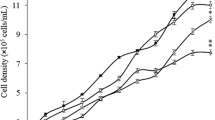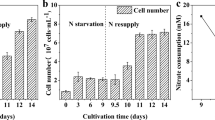Abstract
Under stress conditions, some microalgae up-regulate certain biosynthetic pathways, leading to the accumulation of specific compounds. For example, changing nutrient composition can induce stress in algae’s physiological activities, which may trigger an intense increase in carotenoid production. In this study, the change of photosynthetic functions and carotenoid production in the green microalga Scenedesmus sp. was investigated when algal cultures were exposed to conditions including limited nitrogen content with the addition of sodium acetate. Microalgal cultures were treated for 18 days under higher irradiance conditions. We observed a decrease of chlorophyll content induced concomitantly with a decline of photosystem II and I photochemistry. At the same time, an important increase in carotenoid content was detected. By using high-performance liquid chromatographic analysis, we found that the secondary carotenoids astaxanthin and canthaxanthin were accumulated compared to controls. During the process of carotenoid accumulation, chlorophyll degradation was found in addition to a strong decrease in photosynthetic electron transport. Such changes may be associated with the structural reorganization of the photosynthetic apparatus and can be a useful indicator of secondary carotenoid accumulation in algal cultures.






Similar content being viewed by others
References
Bilger W, Björkman (1990) Role of the xanthophyll cycle in photoprotection elucidated by measurements of light-induced absorbance changes, fluorescence and photosynthesis in leaves of Hedera canariensis. Photosynth Res 25:173–185
Bhosale P (2004) Environmental and cultural stimulants in the production of carotenoids from microorganisms. Appl Microbiol Biotechnol 63:351–361
Borowitzka MA, Huisman JM, Osborn A (1991) Culture of the astaxanthin-producing green alga Haematococcus pluvialis. 1—Effects of nutrients on growth and cell type. J Appl Phycol 3:295–304
Boussiba S (2000) Carotenogenesis in the green alga Haematococcus pluvialis: cellular physiology and stress response. Physiol Plant 108:111–117
Boussiba S, Bing W, Yuang J-P, Zarka A, Chen F (1999) Changes in pigments profile in the green alga Haemotococcus pluvialis exposed to environmental stresses. Biotech Lett 21:601–604
Choudhari SM, Ananthanarayan L, Singhal RS (2008) Use of metabolic stimulators and inhibitors for enhanced production of β-carotene and lycopene by Blakeslea trispora NRRL 2895 and 2896. Bioresour Technol 99:3166–3173
Cosgrove J, Borowitzka M (2006) Applying pulse amplitude modulation (PAM) fluorometry to microalgae suspension: stirring potentially impacts fluorescence. Photosynth Res 88:343–350
Cysewski GR, Lorenz RT (2004) Industrial production of microalgal cell-mass and secondary products—species of high potential: Haematococcus. In: Richmond A (ed) Handbook of microalgal culture: biotechnology and applied phycology. Blackwell, Oxford, pp 281–288
Genty B, Briantais J-M, Baker NR (1989) The relationship between the quantum yield of photosynthetic electron transport and quenching of chlorophyll fluorescence. Biochim Biophys Acta 990:87–92
Guerin M, Huntley ME, Olaizola M (2003) Haematococcus astaxanthin: applications for human health and nutrition. Trends Biotech 21:210–216
Hagen C, Braune W, Björn LO (1994) Functional aspects of secondary carotenoids in Haematococcus lacustris (Volvocales). III. Action as a “sunshade”. J Phycol 30:241–248
Hagen C, Grünewald K, Schmidt S, Müller J (2000) Accumulation of secondary carotenoids in flagellates of Haematococcus pluvialis (Chlorophyta) is accompanied by an increase in per unit chlorophyll productivity of photosynthesis. Eur J Phycol 35:75–82
Hagen C, Grünewald K, Xyländer M, Rothe E (2001) Effect of cultivation parameters on growth and pigment biosynthesis in flagellated cells of Haematococcus pluvialis. J Appl Phycol 13:79–87
Higuera-Ciapara I, Félix-Valenzuela L, Goycoolea FM (2006) Astaxanthin: a review of its chemistry and applications. Crit Rev Food Sci Nutr 46:185–196
Jin ES, Polle JEW, Lee HK, Hyun SM, Chang M (2003) Xanthophylls in microalgae: from biosynthesis to biotechnological mass production and application. J Microbiol Biotechnol 13:165–175
Jin E, Lee C-G, Polle JEW (2006) Secondary carotenoids accumulation in Haematococcus (Chlorophyceae): biosynhtesis, regulation, and biotechnology. J Microbiol Biotechnol 16:821–831
Juneau P, Le Lay P, Böddi B, Samson G, Popovic R (2002) Relationship between the structural and functional changes of the photosynthetic apparatus during chloroplast–chromoplast transition in flower bud of Lilium longiflorum. Photochem Photobiol 75:377–381
Kim JH, Glick RE, Melis A (1993) Dynamics of photosystem stoichiometry adjustment by light quality in chloroplasts. Plant Physiol 102:181–190
Kitajima M, Butler WL (1975) Quenching of chlorophyll fluorescence and primary photochemistry in chloroplasts by dibromothymoquinone. Biochim Biophys Acta 376:105–115
Klughammer C, Schreiber U (1994) An improved method, using saturating light pulses, for the determination of photosystem I quantum yield via P700+-absorbance changes at 830 nm. Planta 192:261–268
Kobayashi M, Kakizono T, Nagai S (1993) Enhanced carotenoid biosynthesis by oxidative stress in acetate-induced cyst cells of a green unicellular alga, Haematococcus pluvialis. Appl Environ Microbiol 59:867–873
Kuzina V, Cerdà-Olmedo E (2006) Modification of sexual development and carotene production by acetate and other small carboxylic acids in Blakeslea trispora and Phycomyces blakesleeanus. Appl Environ Microbiol 72:4917–4922
Ladygin VG (2000) Biosynthesis of carotenoids in the chloroplasts of algae and higher plants. Russ J Plant Physiol 47:796–814
Lee Y-K (2001) Microalgal mass culture systems and methods: their limitation and potential. J Appl Phycol 13:307–315
Lichtenthaler HK (1987) Chlorophylls and carotenoids: pigments of photosynthetic membranes. Meth Enzymol 148:349–382
Lorenz RT, Cysewski GR (2000) Commercial potential for Haematococcus microalgae as a natural source of astaxanthin. Tibtech 18:160–167
Perreault F, Ait Ali N, Saison C, Popovic R, Juneau P (2009) Dichromate effect on energy dissipation of photosystem II and photosystem I in Chlamydomonas reinhardtii. J Photochem Photobiol B 96:24–29
Plaza M, Santoyo S, Jaime L, García-Blairsy Reina G, Herrero M, Señoráns FJ, Ibáñez E (2010) Screening for bioactive compounds from algae. J Pharmaceut Biomed Anal 51:450–455
Qin S, Liu G-X, Hu Z-Y (2008) The accumulation and metabolism of astaxanthin in Scenedesmus obliquus (Chlorophyceae). Process Biochem 43:795–802
Qu C-B, Wu Z-Y, Shi X-M (2008) Phosphate assimilation by Chlorella and adjustment of phosphate concentration in basal medium for its cultivation. Biotech Lett 30:1735–1740
Rippka R, Deruelles JB, Herdman M, Waterbury B, Stanier RY (1979) Assignments, strain history and properties of pure cultures of cyanobacteria. J Gen Microbiol 111:1–61
Schreiber U, Schliwa U, Bilger W (1986) Continuous recording of photochemical and non-photochemical chlorophyll fluorescence quenching with a new type of modulation fluorometer. Photosynth Res 10:51–62
Skulberg OM (2004) Bioactive chemicals in microalgae. In: Richmond A (ed) Handbook of microalgal culture. Blackwell, Oxford, pp 485–512
Steinbrenner and Linden (2003) Light induction of carotenoid biosynthesis genes in the green alga Haematococcus pluvialis: regulation by photosynthetic redox control. Plant Molec Biol 52:343–356
Torzillo G, Goksan T, Faraloni C, Kopecky J, Masojídek J (2003) Interplay between photochemical activities and pigment composition in an outdoor culture of Haematococcus pluvialis during the shift from the green to red stage. J Appl Phycol 15:127–136
Wang B, Zarka A, Trebst A, Boussiba S (2003) Astaxanthin accumulation in Haematococcus pluvialis (Chlorophyceae) as an active photoprotective process under high irradiance. J Phycol 39:1116–1124
Young AJ (1993) Factors that affect the carotenoid content and composition of higher plants and algae. In: Young AJ, Britton G (eds) Carotenoids in photosynthesis. Chapman and Hall, London, pp 160–205
Yuan J-P, Chen F (1999) Hydrolysis kinetics of astaxanthin esters and stability of astaxanthin of Haematococcus pluvialis during saponification. J Agric Food Chem 47:31–35
Zhang D-H, Lee Y-K (2001) Two-step process for ketocarotenoid production by a green alga, Chlorococcum sp. strain MA-1. Appl Microbiol Biotechnol 55:537–540
Zlotnik I, Sukenik A, Dubinsky Z (1993) Physiological and photosynthetic changes during the formation of red aplanospores in the chlorophyte Haematococcus pluvialis. J Phycol 29:463–469
Acknowledgments
This work was supported by NSERC discovery grant of R. Popovic. M Darwish is supported by an NRC post-doctoral fellowship. F. Perreault is supported by a NSERC PhD fellowship.
Author information
Authors and Affiliations
Corresponding author
Rights and permissions
About this article
Cite this article
Pirastru, L., Darwish, M., Chu, F.L. et al. Carotenoid production and change of photosynthetic functions in Scenedesmus sp. exposed to nitrogen limitation and acetate treatment. J Appl Phycol 24, 117–124 (2012). https://doi.org/10.1007/s10811-011-9657-4
Received:
Revised:
Accepted:
Published:
Issue Date:
DOI: https://doi.org/10.1007/s10811-011-9657-4




